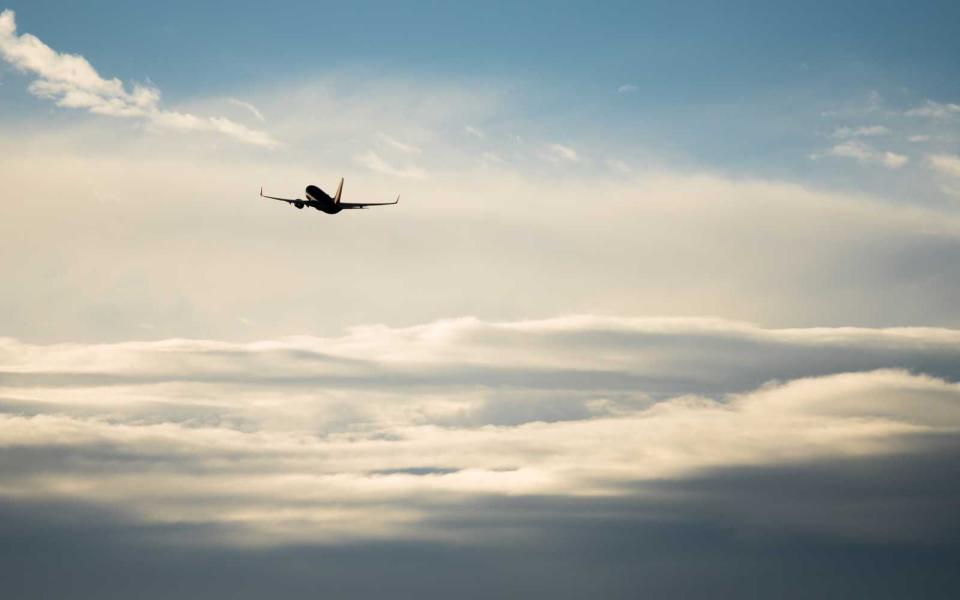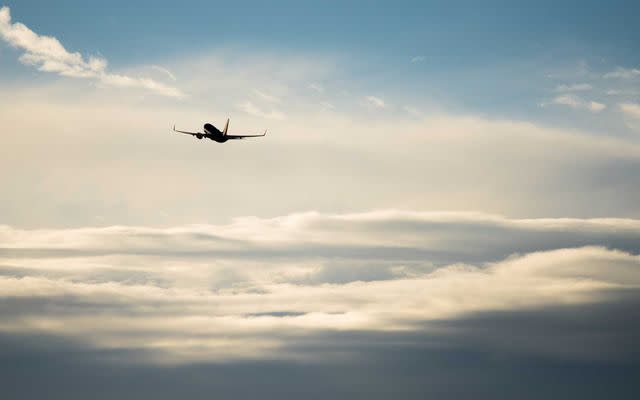How High Do Planes Fly?

And why 36,000 feet is the most common altitude.

Fact checked by Jillian Dara
It's a common situation for travelers. You fasten your seat belt, listen to the pre-flight safety demonstration (we hope), and prepare yourself for takeoff. After a few moments, the pilot comes on the overhead, "Ladies and gentlemen, we are now at our cruising altitude of 36,000 feet."
It's time to kick back and wait for that refreshment cart to come around. But how many of us have stopped to ask ourselves how high do planes fly? According to USA Today, the common cruising altitude for most commercial airplanes is between 33,000 and 42,000 feet, or between about six and nearly eight miles above sea level.
Typically, aircraft fly around 35,000 or 36,000 feet in the air. To put that in perspective, the peak of Mount Everest measures 29,029 feet. But this is why we have pressurized cabins: so you don't feel as if you're literally trying to breathe on top of Mount Everest. The area is called the lower stratosphere, which is just above the troposphere, the lowest part of the atmosphere, according to the UCAR Center for Science Education. Flying in this area has many benefits that make flying one of the leading ways for travelers to get from one place to another.
Although it's not impossible to fly higher than that — the altitude record is contested between the U.S. and the former USSR according to The Smithsonian — you can rest assured that there are many good reasons your plane will stay a bit closer to the ground.

Fuel Efficiency
The biggest reason for flying at higher altitudes lies in fuel efficiency. The thin air creates less drag on the aircraft, which means the plane can use less fuel in order to maintain speed. Less wind resistance, more power, less effort, so to speak. This is also the reason why it's called "cruising" altitude, because the plane is "sailing" through the air along the path of least resistance.
Spending less on fuel is great for airlines, for obvious reasons, but a plane's engines also need oxygen in order to work, according to Traveller, to create combustion, which also creates energy. So, flying too high can also cause problems because the air is much thinner. Plus, the higher a plane goes, the more fuel it has to burn in order to get there so there are some drawbacks with certain altitudes as well.
Avoiding Traffic and Hazards
Planes don't always fly at the same altitude, and that's for a very good reason that many of us wish we could do on the ground — avoiding traffic. Flying higher means planes can avoid birds (usually), drones, and light aircraft and helicopters, which fly at lower altitudes. According to Your Mileage May Vary, the direction in which your plane is traveling can also affect what altitude it will climb to. Planes flying eastward (including northeast and southeast) will fly at odd altitudes (i.e. 35,000 feet) and all other directions will fly at even altitudes. Routes going in the same direction are also often planned so that planes are 1,000 feet above or below each other to avoid a collision.
Weather
Have you ever wondered why the view outside your plane window can be sunny one moment and rainy the next upon descending into your destination airport? That has everything to do with the altitude. Most planes are flying above the troposphere, where weather events usually happen, according to Traveller.
Turbulence
Of course, turbulence still happens on airplanes, but you may be surprised to know that it happens a great deal less because of the high altitude of many commercial flights. According to The Points Guy, when planes run into air pockets and fierce winds, air traffic controllers can sometimes suggest different altitudes to avoid it. According to USA Today, flying higher can actually minimize turbulence.
Emergencies
A higher altitude can also give pilots one precious commodity when they're up in the air: time. According to Traveller, should something happen that would warrant an emergency landing, the high altitude gives pilots much longer to fix the situation or find a safe place to land than if they were on a light aircraft cruising at 10,000 feet.
Different Planes, Different Altitudes
Not all planes are made to cruise at the same altitude. According to Thrillist, a plane's altitude is determined by its current weight and the atmospheric conditions at the time of flight. A flight's direction (as mentioned above), the amount of turbulence (based on reports by other pilots in the air), and flight duration are also factors.
Who Makes The Call?
Despite pilots being in control of the plane, they aren't the ones who decide on its altitude. Air dispatchers, instead, are in charge of planning and deciding a plane's route, including altitude, as well as tracking where an aircraft is in the air. According to an interview with Richard Taylor of the CAA in Traveller, there are laws in place that dictate aircraft must not fly "below 1,000 feet over a built-up area, or 500 feet over any person, vehicle or structure."
For more Travel & Leisure news, make sure to sign up for our newsletter!
Read the original article on Travel & Leisure.